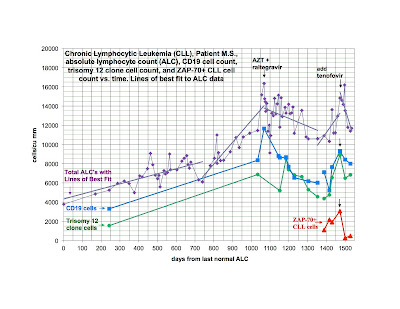I went down for a while after I wrote the last blog. I was feeling poorly and it was coloring my outlook, so I didn’t want to write anything I’d regret. I’ve been in Kapa’au, on the Big Island, for the last two weeks seeing patients and have felt noticeably better since I arrived. Pretty definite cause and effect. It’ll be interesting to see if it lasts through a third week, when the benefit of the altitude change should be over; this is the first time I’ve stayed so long. I still think that altitude is a major factor for me. My CBC was normal before this trip, for the first time off AZT for 6 months, but also for the first time in years, because my Hct was above reference after my move to Santa Fe, and is now 41, with normal indices.
When I felt myself dip, I stopped Isentress, because experience has taught me that when things are going south, stop what you can. I was all over the place at the time, but didn’t notice anything I would call better or worse from stopping the drug. As usual with clinical medicine, especially with this disease, there are confounders, so I suppose you could interpret my current upswing as improvement from stopping Isentress, but I really doubt it. I think that it did something at the beginning (but certainly can’t prove it), and then was doing nothing. One of the interesting things that is emerging anecdotally is that the assumption, born from the experience of HIV, that if the drugs work they must be taken forever, could be incorrect for us. There are reports of patients improving from arv’s, going off for one reason or another, and holding the improvement, or even improving further. It is a relapsing remitting illness. Maybe the drugs can induce latency, which can be maintained in other ways. I remain on Viread, considering what is next. Of note is that a few people have improved on arv’s other than the three that Singh found inhibited VP62.
Here are some cautions about the use of arv’s for ME/CFS, information gathered from our intrepid trail blazers. There are two patients who have had renal function elevation from tenofovir. One discontinued and one reduced to half dose, with return to baseline renal function, but isn’t doing as well clinically as before on the full dose. My understanding is that HIV patients without preexisting renal disease aren’t expected to have this problem, so more frequent monitoring is a good idea for CFS patients. When tenofovir goes bad for HIV patients, it causes a renal mitochondropathy and our mitochrondrial function is already problematic, so we may be more sensitive, as we are to drugs in general. We were checking safety labs every three months and have upped it to every two.
Arv’s cause a “herx”, or cytokine flare, for most. I have heard of one patient who flared with arv’s, took them only briefly (no AZT), stopped them in April and is still worse than before, at a lower level of function, though seems to be slowly returning to baseline. She says she went into it with her eyes wide open. We all owe her a debt of gratitude.
My impression is that patients who have had other problems addressed first have an easier time of it, and are more likely to respond. So far, I have not prescribed arv’s, not because I’m unwilling, but because there are other things that are more pressing that need to be addressed now. Neglect and/or the indiscriminate use of dangerous drugs characterize the care most have had to date.
My early practice impressions support what I have learned from my email and taking medical information calls for the WPI. We have been incredibly neglected. Doctors hear CFS and they forget everything they do know. They don’t do the regular things. If a healthy woman walks into a doctor’s office complaining of tachycardia and palpitations, with hyperlipidemia and borderline adult onset diabetes, family history of coronary disease, they might worry about it a little, get an EKG, treadmill, maybe try a few things. If a CFS woman walks in, she gets nothing. Doctor goes brain dead. They don’t get it that in addition to our weird symptoms, we get the usual things, sooner and worse.
The patients I am seeing are remarkably homogeneous. Clinically however, the money is going to be in the differences, looking at the way the disease has progressed in each person, where the vulnerabilities are, and what can be tipped in the patient’s favor. The most common possible intervention, likely to impact quality of life (besides stopping meds) is hormone replacement/balancing. In my last practice, in addition to other things, I did a lot of weaning patients from meds, with the support of neurofeedback, and also, hormone balancing, for women like myself, who were having a terrible perimenopause, after a normal menstrual and reproductive history. They were mostly in their 40’s. In this practice, I am seeing women who need the same thing, but they are in their 20’s. What was PMS for my generation is now PCOS for the next generation. And men have the same hormone problems, depletion and receptor insensitivity.
Bioidentical hormone replacement means using preparations that provide the body with the same molecule it makes on its own. In conventional practice, most doctors use synthetic hormone-like drugs, Prempro, for example, or birth control pills for young women. The Pre is Premarin, which stands for pregnant mare urine; it is a lot like human estrogen, but not the same. The Pro is Provera, a progesterone-like drug, probably responsible for the increased cardiovascular risk found in the Women’s Health Initiative, that killed HRT for the average woman. Bioidentical hormones have never been seriously studied, and probably never will be, because they are naturally occurring substances and therefore, not patentable.
I am seeing families, husband/wife, mother/daughter; there is a CFS mother/autistic son scheduled for next trip. We are making progress on the family survey, though it isn’t quick, very labor intensive. Everyone helping is sick and we have no funding. Down and dirty… it can take more than 20 years for a spouse to get sick. Kids go down much earlier than their mothers did and are much sicker. If you have CFS, your chances of having an autistic first degree relative is very high. Real numbers forthcoming…
 |
| Yesterday – Ali’s newest FaceBook picture |
Ali is doing fantastically well. Her MCS symptoms have mostly resolved, to the point that she can get out again and be in places where there are chemical smells, like the hair dresser and the lab. Oxygen has been huge for her. She uses oxygen at 10L/min by non-rebreather mask for about an hour a day. She does it without prompting and she uses it for rescue if she does feel sick. We have it set up with the concentrator in the middle of the house and a long hose that goes anywhere. Then you don’t have to listen to the noise it makes. She tried the chamber once, felt sick from the pressurization, didn’t finish a full treatment and has declined to use it since. She says it is unnecessary, since she is doing so well. I have been using the chamber irregularly, partly because of all the travel. Normobaric oxygen is helpful for me, but a chamber treatment is clearly better. The problem is I don’t do it, because I’m not a great patient:). It’s much easier to use the concentrator alone. Being able to just grab the mask is wonderful, because it’s something immediate that you can do for yourself. It helps me within 10 minutes when I really dip.
Options for trying oxygen? It comes in big tanks that are inexpensive (~ $20/tank), but at high flows, a tank doesn’t last long. Insurance will sometimes cover oxygen for migraines, otherwise, in most areas you can find an oxygen supply company that will rent you a concentrator for about $200/month. Often they only have ones that go to 6L. The delivery device needs to be matched to the flow rates. A cannula can go up to 6L/min (FiO2, or inspired fraction of oxygen, 24-40%, instead of 21% room air), but is really comfortable only at 2L/min. You can go to 6L/min with a mask (FiO2 up to 50%). A non-rebreather mask has a reservoir that holds the oxygen with a one way valve that lets it come in to the mask with inhalation. There are also valves on the side of the mask that let the exhaled gases out, including CO2. A non-rebreather mask requires a flow rate of at least 10L/minute and gets 60-90% depending on fit. Concentrators are sometimes available used, after people die. They should be serviced before use.
The only absolute contraindication for hyperbaric (not oxygen alone) is the presence of a pneumothorax. Other contraindications are hereditary spherocytosis, prior treatment with bleomycin or cisplatinum, concurrent treatment with disulfiram, doxorubicin or sulfamylon. Relative contraindications, or conditions requiring close monitoring are problems clearing ears, asthma or anything causing air trapping, and epilepsy or high fever, because high dose oxygen lowers seizure threshold. Pacemakers and implanted pumps should be cleared with the manufacturer. High dose oxygen may accelerate the maturation of cataracts, but isn’t thought to cause them de novo. A disclaimer, like on a drug commercial:).
I receive mail from people who have asked their doctors to prescribe oxygen for them and been told it’s too dangerous. Please ask them why they think so. Doctors have a visceral fear of oxygen and are not knowledgable with respect to its use. They were taught about COPD and hypoxic drive; COPDer’s who retain CO2 at baseline, in crisis can become obtunded and decompensate further, if given high dose oxygen. Practically speaking, by the time that happens, they are probably going to need intubation anyway, and in reality, even those patients tolerate oxygen just fine when they are not in trouble. I treated people with COPD and CO2 retention with HBOT for brain injury, 1.5 ATA 100% O2 delivered by hood for an hour in a multiplace chamber with attendant present, for 40+ treatments, without problems.
We have continued Ali’s modified Meyer’s cocktail (containing Leucovorin 10mg), followed by a glutathione push. She gets a clear lift from the infusions lasting a week or two. She comes to me when she wants one. Because I was going to be away this time for three weeks, she started oral folinic acid 800 mcg daily, then increased to 1600 mcg, and she has continued uphill in my absence.
Oxygen and folic acid derivatives seem worth a try for pretty much everybody with ME/CFS, except perhaps, if there’s a history of cancer also, further consideration is warranted. Deplin (prescription high dose L-methylfolate), folinic acid, 5-MTHF. Side effects are limited to overactivation/sleep disruption, and are dose related. However, for every intervention, no matter how benign, there seems to be someone who has been made worse by it… Folic acid derivatives should be taken with B-complex and extra B-12. A few people get overactivated with too much B-12, so, as always, it is a good idea to start things one at a time, and if that happens, maybe try again another time at a lower dose.
I have been deeply touched by the many expressions of concern I have received from readers during my short writing hiatus. It is amazing to me that so many people I’ve never met aren’t strangers, but friends sharing a common experience. So here we are, together again, waiting to see what will unfold in Ottawa.
Exciting news from Dr. Snyderman coming soon…





